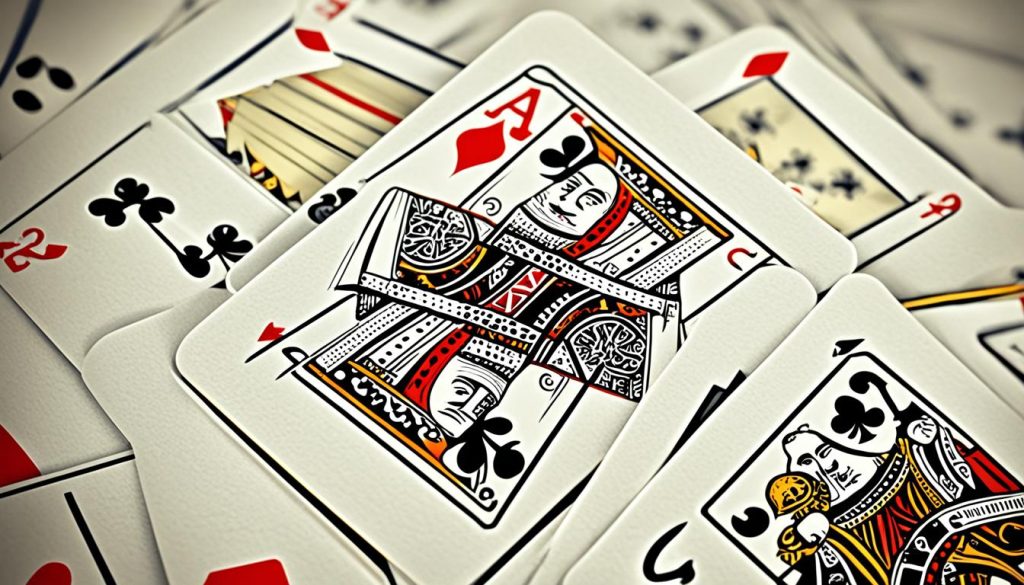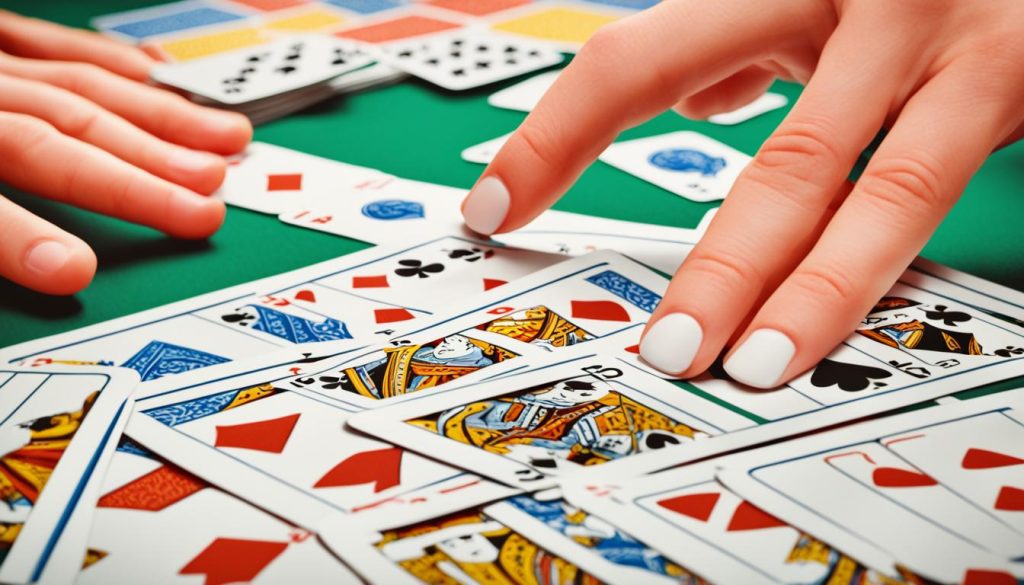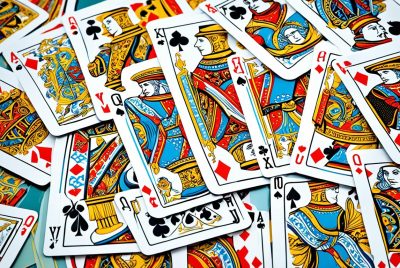Understanding Card Markings in Card Games: Detecting Tricks
Have you ever wondered how card cheats manage to outsmart their opponents with uncanny precision? How can they consistently know which cards are in play, even when others are shuffling and dealing? The answer lies in a technique known as card marking.
Card marking is a process where playing cards are altered in a way that only the marker or conspirator can see the marks. This clandestine practice is employed by card sharps to cheat in card games or by magicians to perform mind-boggling tricks. But how can one detect these deceptive markings? Let’s explore the world of card marking detection and delve into the secrets of unmasking these tricks.
Key Takeaways:
- Card marking is a technique used by cheats to gain an unfair advantage in card games.
- Card marking can be challenging to detect, as markers employ advanced techniques and technologies.
- Casinos modify the decks of cards they sell to prevent cheaters from using marked cards.
- Being vigilant and observant of suspicious behavior can help in detecting card markings.
- Staying informed about card marking detection techniques is crucial for maintaining the integrity of card games.
Purpose of Marking Cards
Card marking serves two main purposes: cheating in card games and performing magic tricks. Cheaters use marked cards to gain an unfair advantage in gambling by identifying specific cards. This allows them to make strategic decisions based on the knowledge of what cards their opponents hold.
Magicians use marked cards to create illusions and perform tricks that appear impossible. By placing subtle marks on the cards, they can secretly identify the chosen card or manipulate the deck to create astonishing effects. Marked cards add an element of mystery and wonder to the magician’s performance, leaving the audience astounded.
To prevent cheating in card games, casinos take precautions by modifying the decks of cards they sell to tourists. These modifications can include punching holes, trimming the edges, or applying special coatings that make it difficult to mark the cards discreetly. These measures help to maintain the integrity of the game and ensure fair play for all participants.

History of Card Marking
Card marking has a long and intriguing history, with techniques evolving over time to outsmart opponents and enhance deception. From humble beginnings, card marking has transformed into a sophisticated art that combines traditional methods with modern technologies.
The earliest forms of card marking involved simple physical alterations, such as bends, crimps, and tiny bumps on the cards. As playing cards started featuring back designs, cheats began to exploit this feature by altering the designs themselves. Inks, pigments, and scratches became common tools for creating hidden marks.
Traditional card marking methods encompass a variety of techniques, each with its own unique approach. Block-out work involves coloring small white areas of the card using the same ink as the back design, effectively hiding the marks in plain sight. Cut-out work, on the other hand, entails scraping off parts of the printed areas on the card to reveal hidden markings beneath.
Other traditional techniques include scroll work, where intricate patterns are engraved or embossed on the card to represent specific values, and shade work, where subtle shades are added to enhance the visibility of the marks under certain lighting conditions. Tint work is a delicate variation of block-out work, using a light tint to discreetly highlight specific details on the card.
With advancements in science and technology, card marking techniques have reached new heights. Modern card marking technologies utilize cutting-edge innovations to create marks that can only be seen with specialized devices. Luminous marking, for instance, involves using invisible inks and a source of ultraviolet light to reveal hidden markings. Juice marking utilizes specially crafted liquids that can only be detected by a trained eye or specific devices.
To gain a deeper understanding of the evolution of card marking techniques, the table below provides a comparison of traditional and modern card marking methods:
| Traditional Card Marking Methods | Modern Card Marking Technologies |
|---|---|
| Block-out work | Luminous marking |
| Cut-out work | Juice marking |
| Scroll work | |
| Shade work | |
| Tint work |
As card marking techniques continue to evolve, so do the methods of detection. The next section will explore various techniques and technologies used to detect card markings and combat cheating in card games.

Key Takeaways
- Card marking has a rich history and has evolved from simple physical alterations to sophisticated methods involving inks, pigments, and technology.
- Traditional card marking techniques include block-out work, cut-out work, scroll work, shade work, and tint work.
- Modern card marking technologies utilize advanced methods such as luminous marking and juice marking.
- The next section will explore the techniques used to detect card markings and prevent cheating in card games.
Types of Card Markings
Card markings come in various forms and are utilized in both card games and magic tricks. Let’s explore some of the different types:
Traditional Card Marking Techniques
Traditional card marking techniques involve altering the design or surface of the cards to create discreet markings. Two common traditional methods include:
- Block-out Work: In this technique, small white areas of the card are colored with the same ink as the back design. This method makes the marks blend seamlessly with the overall card design, making them harder to detect.
- Cut-out Work: In cut-out work, some of the printed areas of the card are deliberately scraped off to reveal hidden markings. This technique requires precision and skill to achieve accurate and subtle markings.
Advanced Card Marking Technologies
Advanced technologies have revolutionized card marking techniques, resulting in more sophisticated and difficult-to-detect markings. Some popular advanced methods include:
- Luminous Marked Cards: These cards are marked with special inks or substances that can only be seen with specific devices, such as contact lenses or sunglasses designed for this purpose.
- Video-Luminous Marked Cards: Video-luminous cards go a step further by utilizing custom-designed electronics and filters for detection. This technology enables the marks to remain invisible to the naked eye, making them virtually undetectable.
- Juice-Marking: Juice-marked cards involve using specially formulated inks or solutions that are visible to a trained observer. This technique requires expertise in recognizing the specific markings.
These advanced card marking technologies have significantly raised the bar for detection, making it more challenging to identify marked cards without the use of specialized tools and training.
| Card Marking Technique | Description |
|---|---|
| Block-out Work | Small white areas of the card are colored with the same ink as the back design. |
| Cut-out Work | Printed areas of the card are scraped off to reveal hidden markings. |
| Luminous Marked Cards | Special inks or substances that can only be seen with specific devices, such as contact lenses or sunglasses. |
| Video-Luminous Marked Cards | Custom-designed electronics and filters for virtually undetectable marks. |
| Juice-Marking | Specially formulated inks or solutions visible to trained observers. |
Understanding the different types of card markings is crucial for detecting potential cheating in card games and magic tricks. The advancement of technologies has led to more sophisticated marking techniques, making detection increasingly challenging.
Techniques for Card Marking
There are various techniques for marking cards used by cheats and magicians. Each technique offers a unique way to alter the appearance of a card, making it undetectable to the untrained eye. Let’s explore some of the traditional card marking methods as well as the shade techniques that have become more prevalent in recent years.
Traditional Card Marking Methods
Traditional card marking methods involve altering the visual elements of a playing card to create subtle markings that can be recognized by the marker or conspirator. These methods include:
- Block-Out Work: This technique involves coloring small white areas of the card using the same ink as the back design. By camouflaging the marks within the card’s design, cheaters can discreetly identify specific cards.
- Tinting: Tinting is a variation of block-out work where certain areas of a detail are lightly tinted with a similar color ink. This technique creates even more inconspicuous markings.
- Cut-Out Work: Cut-out work utilizes a razor or other sharp tool to scrape off parts of the printed areas on the card, revealing hidden marks or symbols. This method requires precision and skill to create markings that are both discernible and hidden.
Shade Techniques
In recent years, shade techniques have gained popularity due to their effectiveness and the advancements in technology. These techniques involve using special inks or solutions to create marks that are only visible under specific conditions or with special devices. Some popular shade techniques include:
- Luminous Marking: With luminous marking, special inks are used to create invisible marks on the cards. These marks can only be seen through the use of devices like UV lights or infrared contact lenses.
- Video-Luminous Marking: Video-luminous marking takes luminous marking to the next level. Custom-designed electronics and filters are integrated into the cards, allowing the marks to be detected through a video system.
- Juice-Marking: Juice-marking involves using a special solution, known as “juice,” to create invisible marks on the cards. The marks can be read by a person trained to recognize them, giving the cheater a significant advantage.
These shading techniques have made it increasingly difficult to detect marked cards, as they require specialized equipment or specific knowledge to reveal the hidden markings. As a result, it’s crucial to stay informed about the latest advancements in card marking detection to prevent cheating in card games and maintain the integrity of gameplay.
| Technique | Description |
|---|---|
| Block-Out Work | Coloring small white areas of the card using the same ink as the back design |
| Tinting | Lightly tinting certain areas of a detail with a similar color ink |
| Cut-Out Work | Scraping off parts of the printed areas on the card using a razor |
| Luminous Marking | Using special inks to create invisible marks on the cards that can only be seen with UV lights or infrared lenses |
| Video-Luminous Marking | Integrating custom-designed electronics and filters into the cards to allow the marks to be detected through a video system |
| Juice-Marking | Creating invisible marks on the cards using a special solution (juice) that can be read by a trained individual |
Conclusion
Card marking is a deceptive practice employed by cheaters to gain an unfair advantage in card games. Detecting card markings can be a challenging task, as cheats often employ advanced techniques and technologies to ensure their marks go unnoticed. However, there are several measures that can be taken to safeguard card games and prevent cheating.
Casinos play a vital role in combating card marking by modifying the decks of cards they sell. These modifications make it difficult for cheaters to use marked cards in the casino environment. By implementing such safeguards, casinos strive to maintain the integrity of card games and ensure a fair playing field for all players.
In addition to the casino’s efforts, players themselves can contribute to the detection and prevention of card marking. Being vigilant and attentive to suspicious behavior can often unveil potential cheating schemes. For example, consistent folding of good hands by a player when their partner has better cards could be indicative of card marking. Staying informed about the latest card marking techniques and being conscious of these signs allows players to protect themselves and the integrity of the game.
Expert tips for card marking detection include studying the behavior and patterns of other players, observing their reactions during the game, and familiarizing oneself with different marking techniques. By increasing their knowledge and awareness, players can actively participate in the prevention of card marking and ensure a fair and enjoyable gaming experience for all.
FAQ
What is card marking?
Card marking is a process where playing cards are altered in a way that only the marker or conspirator can see the marks. This technique is used by card sharps to cheat in card games or by magicians to perform magic tricks.
What is the purpose of marking cards?
Card marking serves two main purposes: cheating in card games and performing magic tricks. Cheaters use marked cards to gain an unfair advantage in gambling by identifying specific cards. Magicians use marked cards to create illusions and perform tricks that appear impossible.
What is the history of card marking?
Card marking has a long history and has evolved over time. The earliest forms of card marking involved bends, crimps, and tiny bumps. Traditional card marking techniques include block-out work, cut-out work, scroll work, shade work, and tint work.
What are the types of card markings?
There are several types of card markings used in card games and magic tricks. Traditional card marking techniques include block-out work, where small white areas of the card are colored with the same ink as the back design, and cut-out work, where some of the printed areas of the card are scraped off. Shade techniques, such as luminous marking, video-luminous marking, and juice-marking, have become more common.
What are the techniques for card marking?
Techniques for marking cards used by cheats and magicians include block-out work, tinting, cut-out work, luminous marking, video-luminous marking, and juice-marking. These techniques involve manipulating the cards in various ways to create marks that can only be seen with special devices or training.
How can card marking be detected?
Detecting card markings can be challenging, as cheats often use advanced techniques and technologies. However, casinos take precautions by modifying the decks of cards they sell to prevent cheaters from using marked cards. Players can also look out for suspicious behavior and stay informed and vigilant to prevent card marking and maintain the integrity of card games.




